This is the West Gate of Yasaka Shrine. This beautiful gate stands at the east end of Shijo Street, which runs through the center of Kyoto. Actually, this West Gate is not the main gate. If you are going to visit Yasaka Shrine, it is still better to visit from the main gate, the South Gate. So, this time, I will introduce Yasaka Shrine by the route entering from the South Gate.
In my previous blog on Gion, I shared the route to Gion without going through Ninen-zaka after Sannen-zaka, but this time I will introduce the route to Yasaka Shrine through Ninen-zaka, focusing on spots that you might inadvertently miss.

For Kiyomizu-dera Temple, please see this.→The Allure of Kiyomizu-dera Temple
For Gion via Sannen-zaka, please open this.→Strolling around Gion
~Ninen-zaka, Ichinen-zaka~
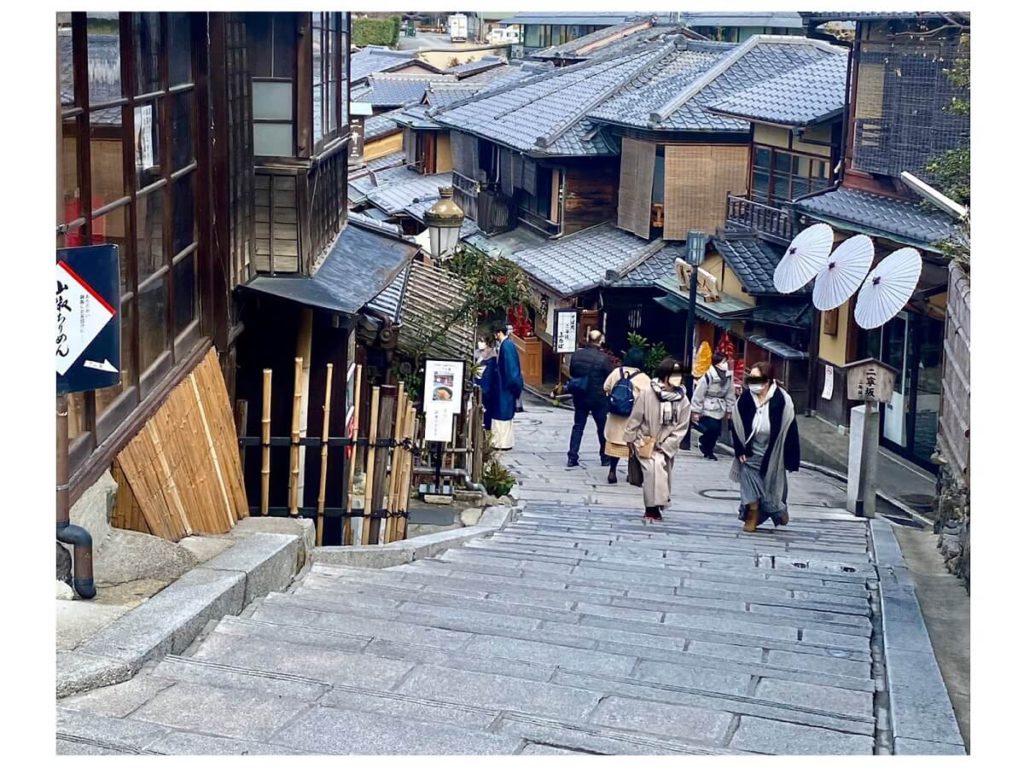
The slope below Sannen-zaka (三年坂, Three-year slope) is called Ninen-zaka (二年坂, Two-year slope), and the slope further down is called Ichinen-zaka (一年坂, One-year slope).
☆Starbucks
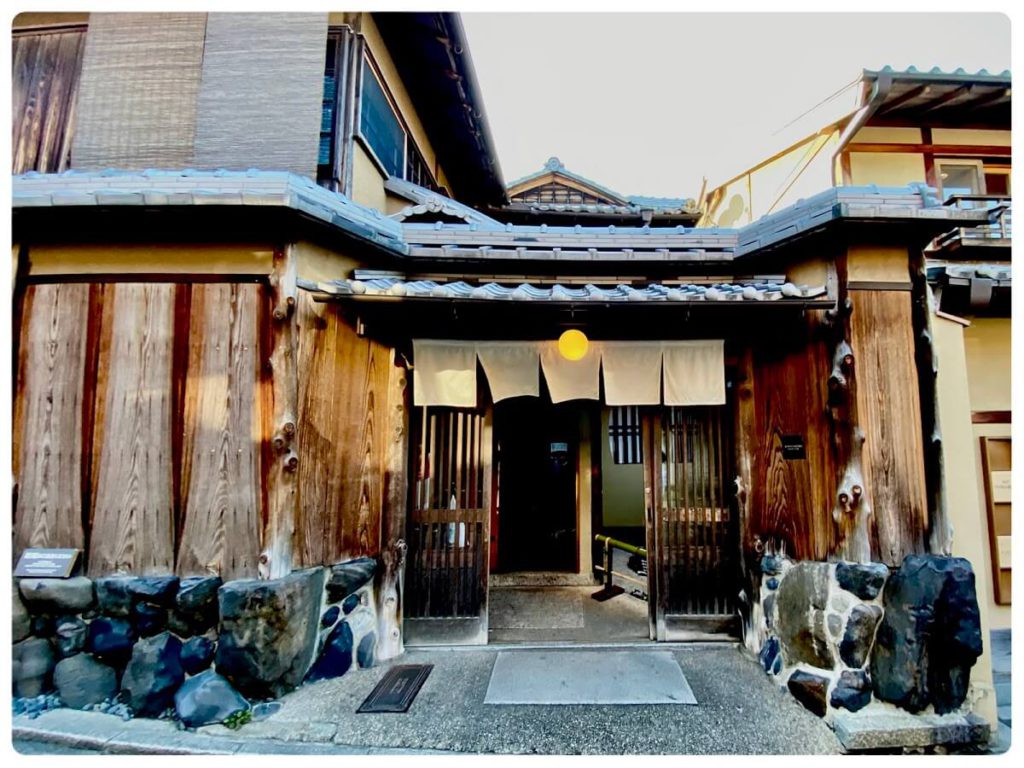
First is the Starbucks on Ninen-zaka. Its design is so well matched to the traditional style of Ninen-zaka that you might not notice it if you were just strolling along. The appearance is completely different from the typical Starbucks, so be careful not to miss it!
Renovated from a 100-year-old Japanese house, this Starbucks has a Japanese atmosphere typical of Kyoto. You can enjoy delicious coffee on tatami mats. It was the first Starbucks store in the world to have a noren (a traditional Japanese store curtain) at the entrance.
•Starbucks Lovers, please also check out this How To Japan article, “Dear Starbucks Lovers.”
☆Donguri Kyowakoku (どんぐり共和国)
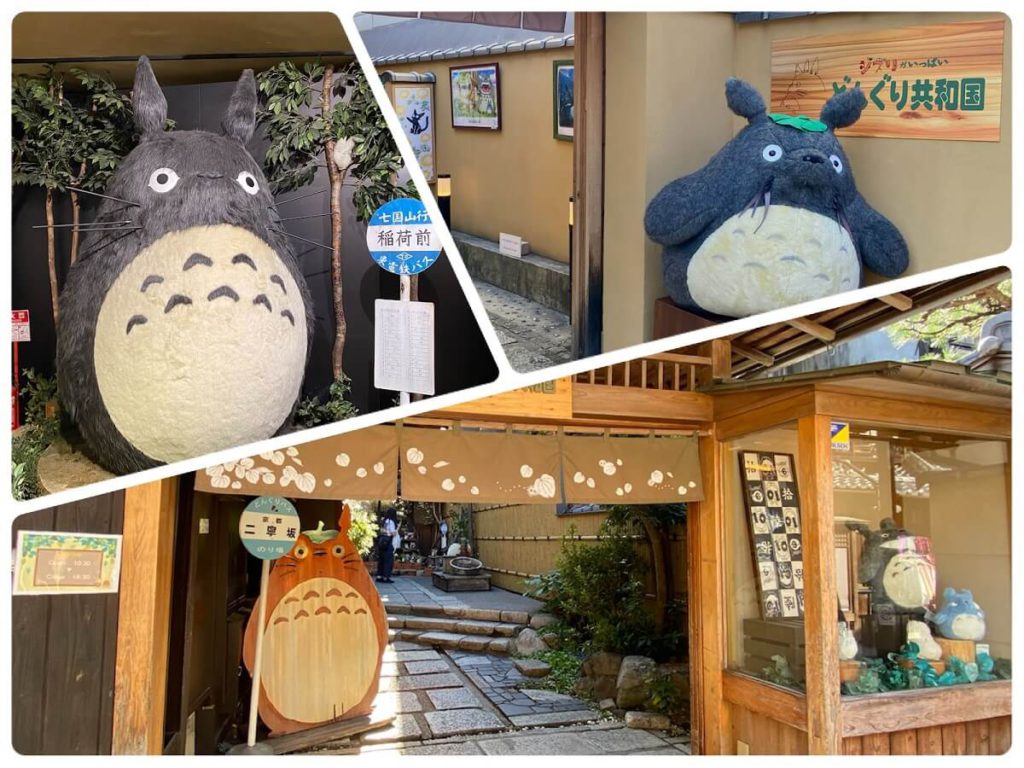
Ghibli lovers will love this store, which sells Studio Ghibli character goods and has many good spots for photos! It is just like a gallery.
~ Nene-no-michi, Ishibe-koji ~
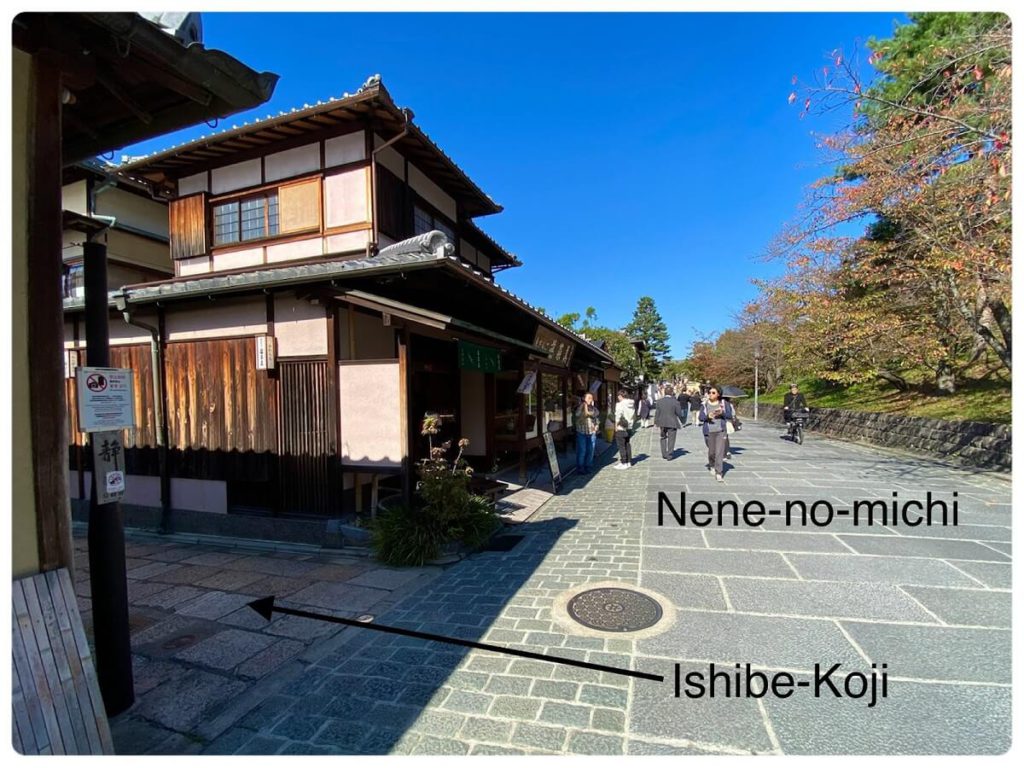
Nene-no-michi (ねねの道) is a beautiful 400-meter-long stone-paved path that continues north on Nichinen-zaka and Ichinen-zaka. It was named “Nene-no-michi” after the wife of Hideyoshi Toyotomi (1537-1598, the samurai, feudal lord, and unifier of Japan), Nene, who spent the rest of her life here.
Just walking along the beautiful cobblestone pavement, you will surely enjoy the atmosphere of the ancient capital, which is typical of Kyoto!
Ishibe-koji (the stone wall path, 石塀小路), which continues from Nene-no-michi, is also a path that embodies the essence of Kyoto. Please take a stroll along it.
☆Ryozen-Kannon (霊山観音)
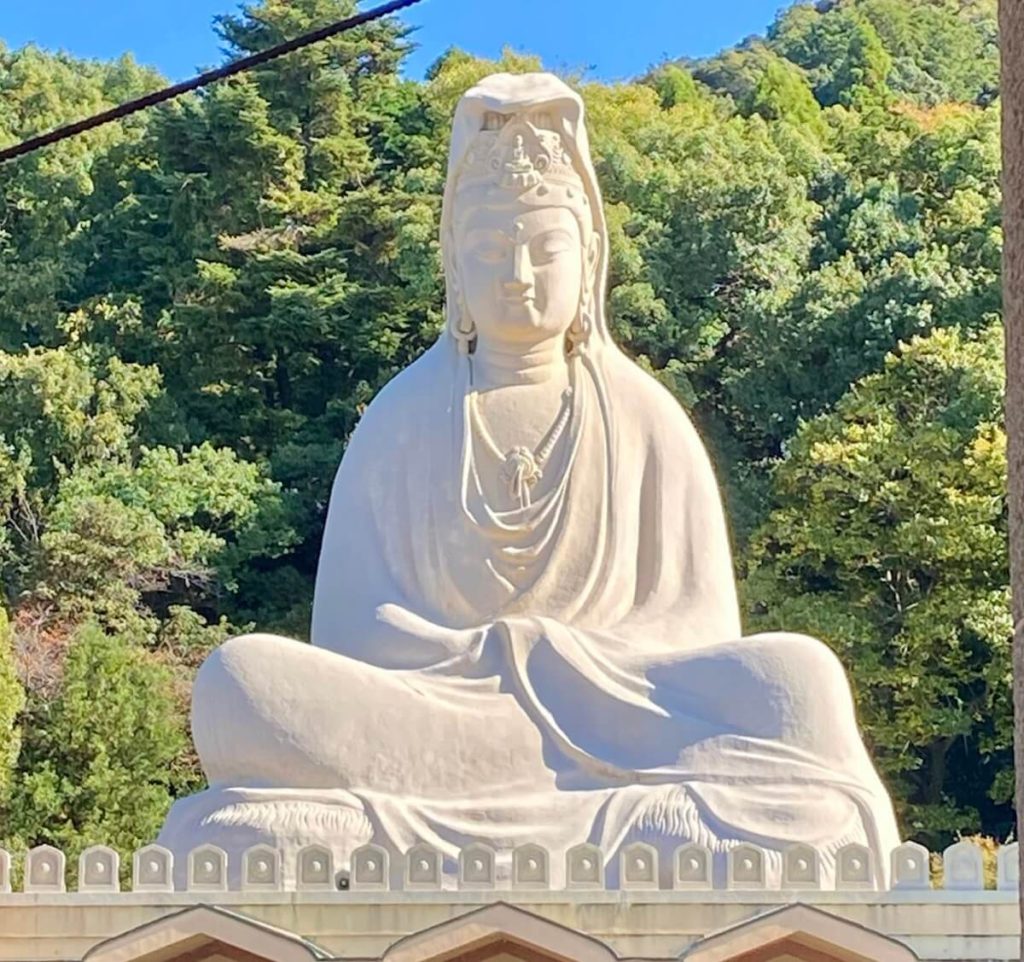
This is a 24-meter seated statue of the Kannon Bodhisattva, which was erected in 1955 to mourn the victims of World War II. Visitors can enter the body of the giant statue to see the enshrined Eleven-faced statue of Kannon.
☆Kodai-ji Temple (高台寺)
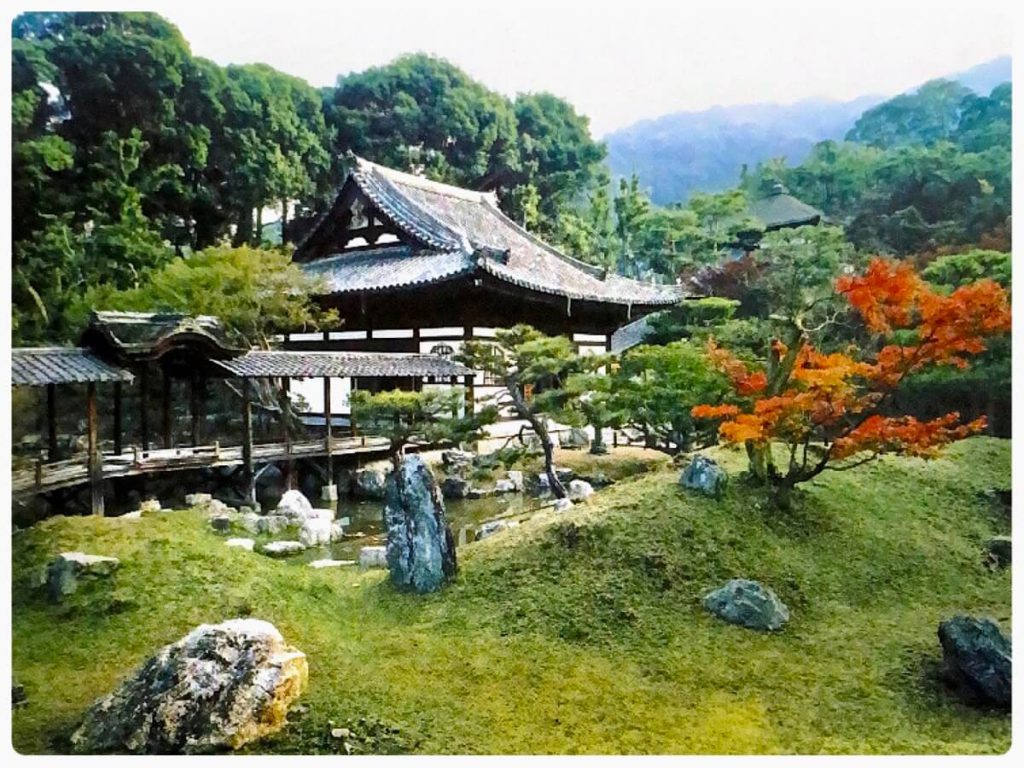
It was founded in 1606 in memory of Toyotomi Hideyoshi by his wife Nene. It belongs to the Rinzai sect of Zen Buddhism and boasts gorgeous interiors and lovely Zen gardens.
☆Doukaku-ji Temple (銅閣寺)

It is a well-known fact that the Golden Pavilion (Kin-kaku-ji, 金閣寺) and the Silver Pavilion (Gin-kaku-ji, 銀閣寺) are in Kyoto. Gold is Kin in Japanese, Silver is Gin and Bronze is Dou. Did you know that there is also the Bronze Pavilion (Dou-kaku-ji, 銅閣寺)?
Built in 1928, it is a 36-meter-high, three-story building with a copper shingle roof, hence the name Doukaku-ji (officially known as Daiun-in Temple, 大雲院). It is usually closed to the public, so it is not well known to the general public.
= Yasaka Shrine (八坂神社) =
Finally we arrive at Yasaka Shrine! Founded over 1350 years ago, Yasaka Shrine is one of the most famous and ancient shrines in Kyoto.
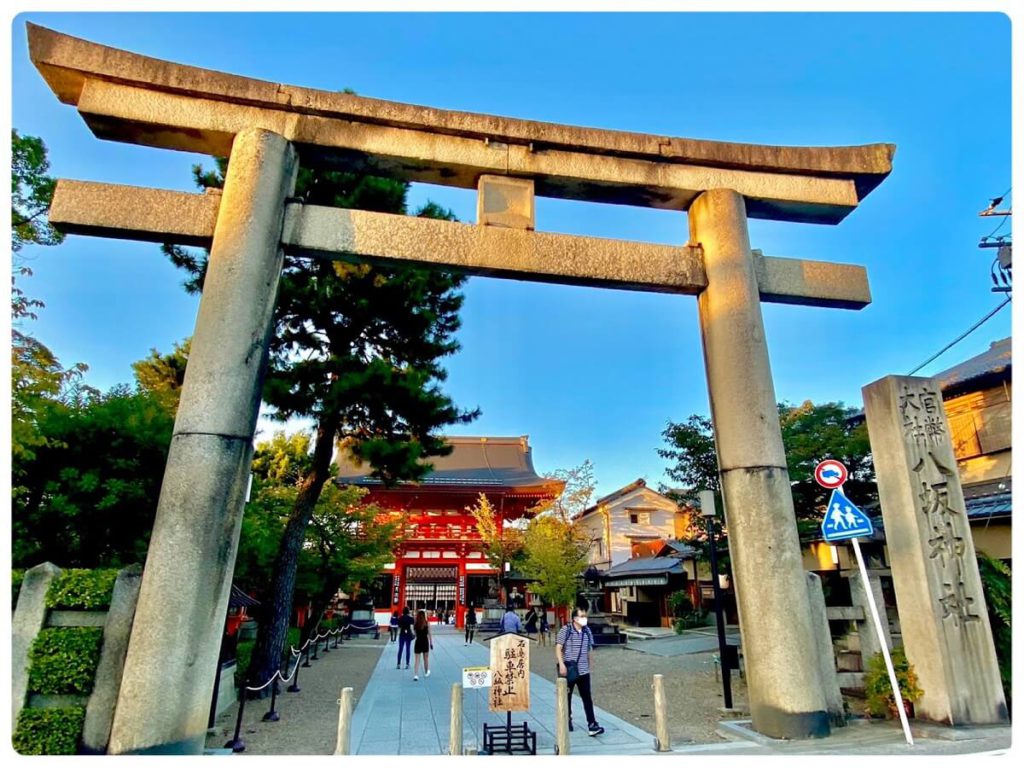
The main gate of Yasaka Shrine can be seen beyond the large stone torii gate. In fact, the official way to enter the shrine is from this South Gate.
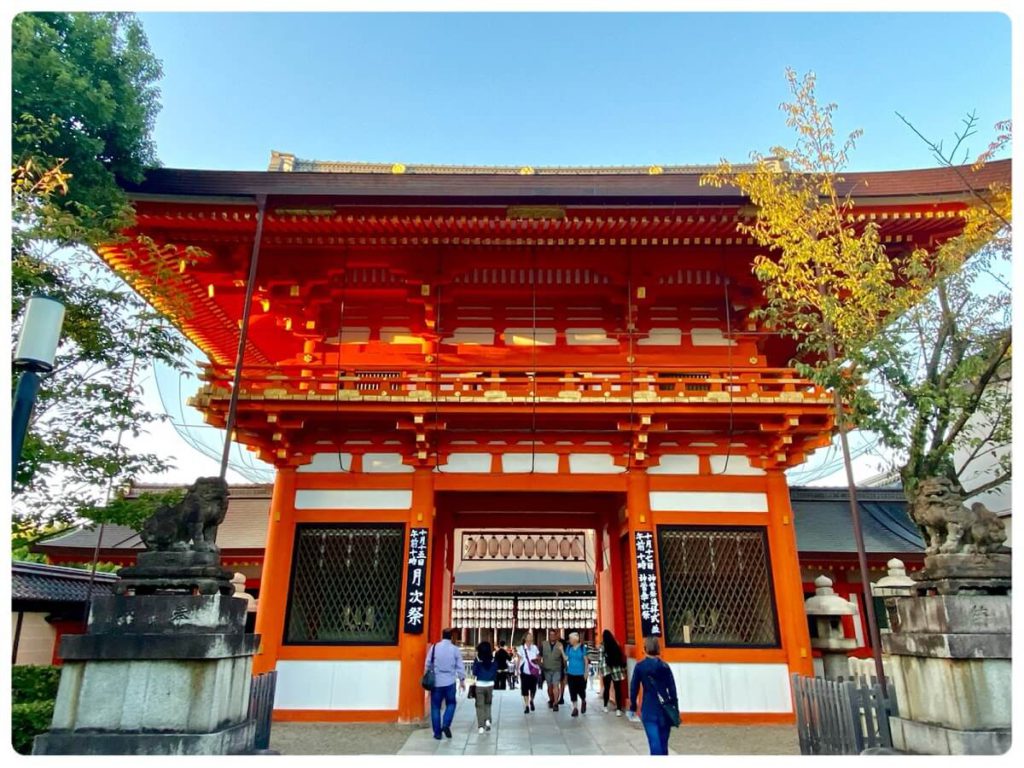
Passing through the South Gate, you will see a water basin on your left and a Noh stage on your right, and in front of you, there is a dance stage with hundreds of lanterns that get lit in the evenings. Each lantern bears the name of a local business in return for a donation.
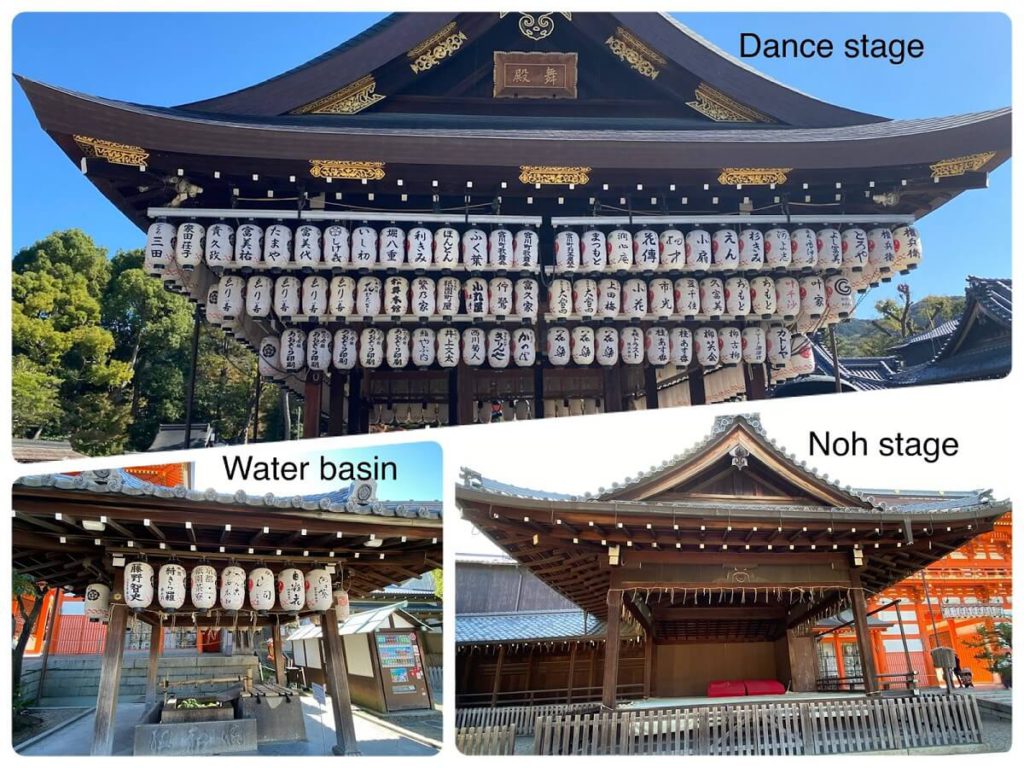
Beyond the dance stage is the main hall, which is built as a single building with the main hall and the worship hall covered by a single large roof. This is a rare architectural style unique to Yasaka Shrine. In 2020, the main hall was designated a National Treasure for its historical and architectural value.
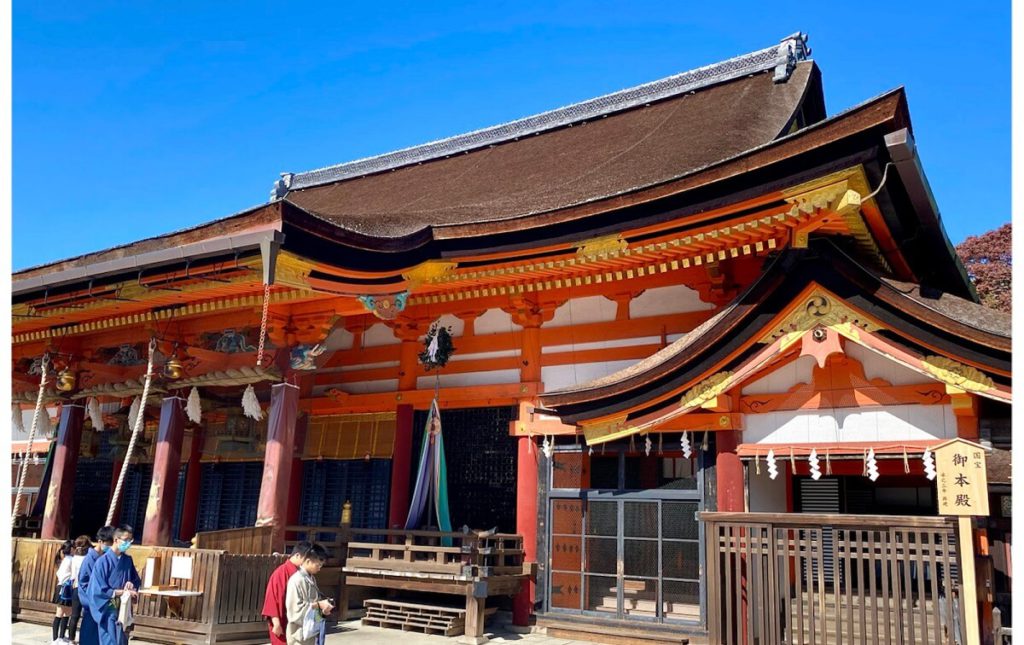
The main hall is surrounded by about 20 smaller shrines. Each shrine is famous for its own special blessings, such as prayers for good luck, marriage, beauty, etc. Some of them are introduced below.
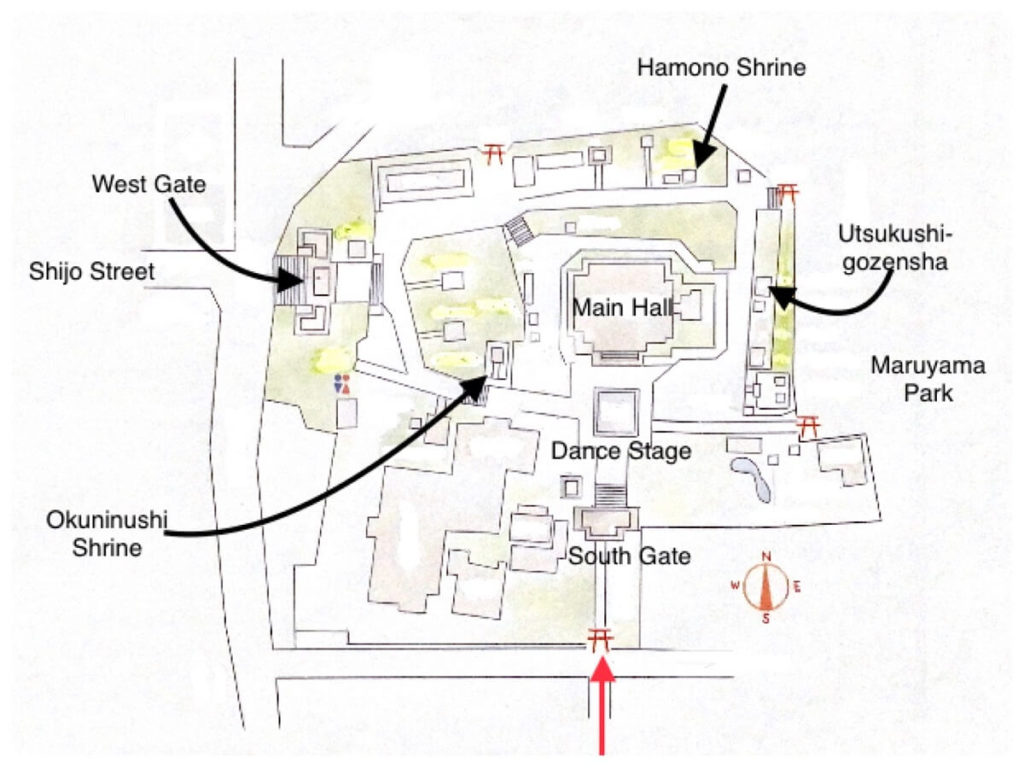
*Utsukushi-gozen-sha (美御前社)

The kanji “美” means beautiful, and this shrine is a spot for revering beauty. It is said that if you put a few drops of “beauty water,” the sacred water that gushes out in front of the shrine, on your skin, you will become more beautiful both physically and mentally.
*Hamono Shrine (刃物神社)
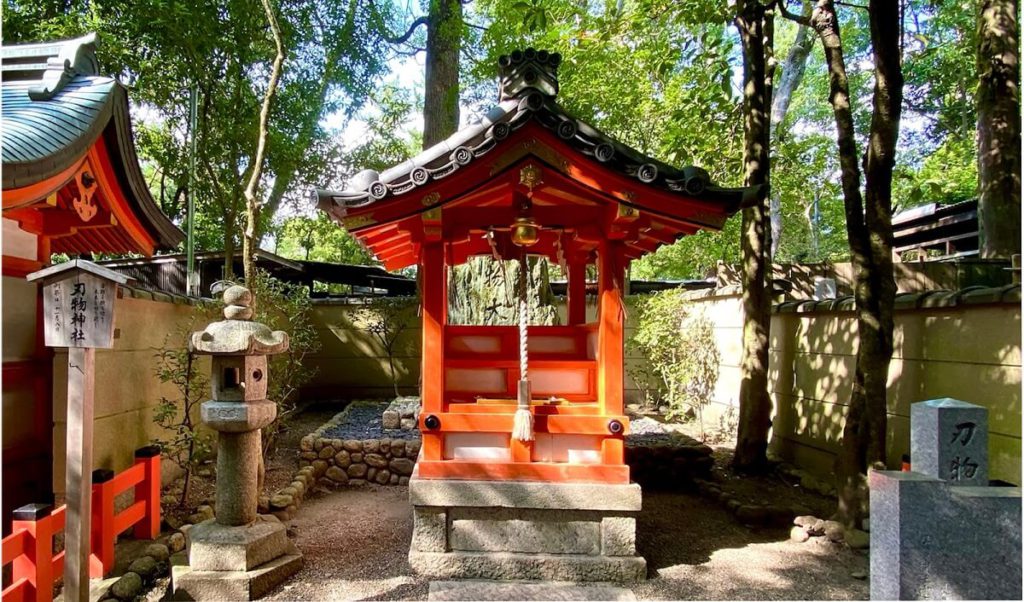
Hamono means cutlery. Kyoto has been the birthplace of cutlery, having produced many master craftsmen in the manufacturing of swords and other cutlery products since ancient times. This shrine was built to commemorate the great achievements of these ancestors, to carry on the traditions, and to promote the industry.
*Okuninushi Shrine (大国主社)
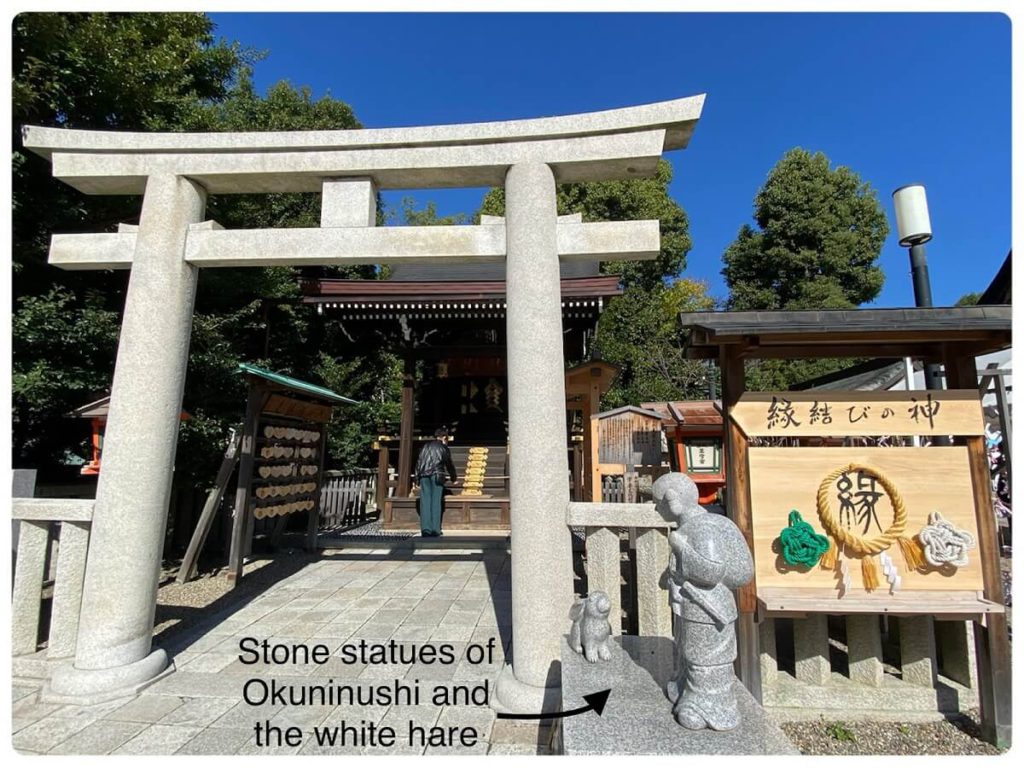
The main deity of Okuninushi Shrine is Okuninushi, who is also regarded as a god of matchmaking.
In front of the shrine, there is a stone statue depicting the scene where Okuninushi helps the hare in the Japanese myth “The White Hare of Inaba.”
Gion Festival (祇園祭)
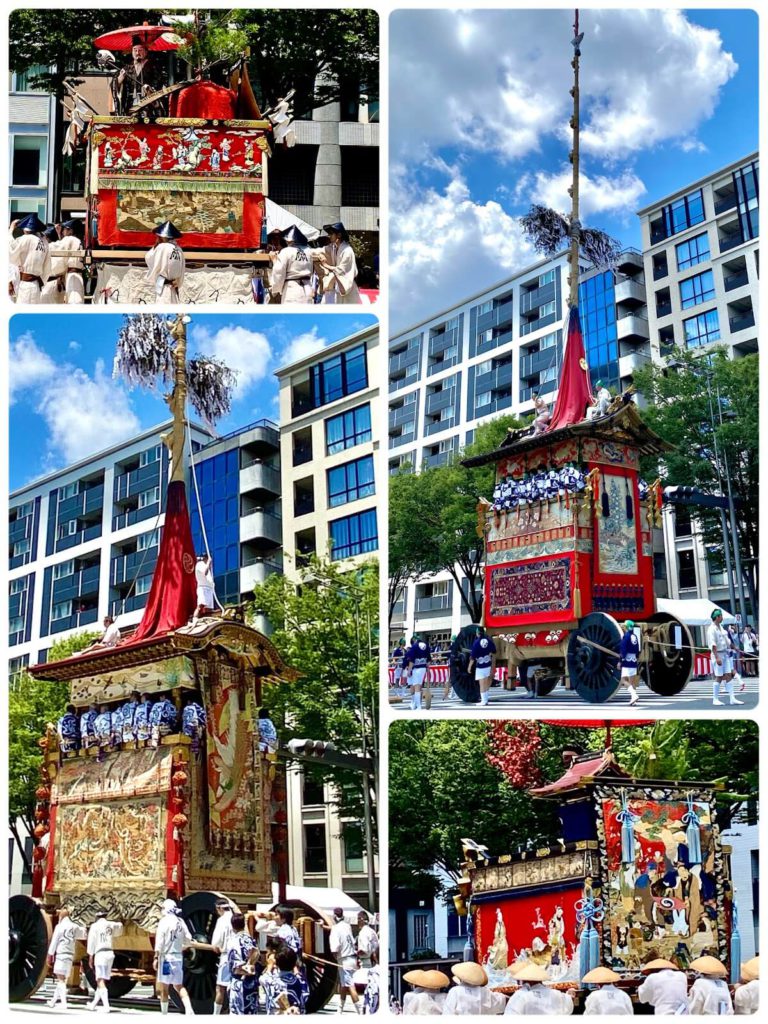
The shrine was called Gion Shrine until 1868, when it changed its name to Yasaka Shrine. It hosts the Gion Festival, one of the three major festivals in Japan. The Gion Festival originated in 869 as a ritual of Yasaka Shrine to pray for the peace of the nation and the eradication of the plague that ravaged the country. The festival lasts for a month from July 1st to 31st, with various ceremonies and events taking place. The highlight of the Gion Festival is the procession of magnificent floats that travel around the town to absorb the misfortune from the spectators, which occurs on July 17th and 24th.
The 2023 parade, which had been canceled and restricted due to the spread of COVID-19, resumed as usual for the first time in four years. As many as 34 floats, adorned with splendid ornaments, moved gracefully along the main streets in Kyoto, hoping to ward off the plague.
The Gion Festival is also known as a moving museum. If you ever have a chance, please come and witness this amazing spectacle.
This time, I introduced the course from Ninen-zaka to Yasaka Shrine, leaving Kiyomizu-dera Temple behind.
Maruyama Park (円山公園), Kyoto’s oldest park opened in 1886, is adjacent to the east side of Yasaka Shrine and is one of the most famous cherry blossom viewing spots in Kyoto. To the north is Chio-in Temple (知恩院), Nanzen-ji Temple (南禅寺), and Philosopher’s Path (哲学の道), which leads to Ginkaku-ji Temple (銀閣寺).
Located in the heart of Kyoto’s eastern cultural heritage, Yasaka Shrine is a historic and sacred site that dates back to even before the Heian period (794-1192). It’s a must-see destination for anyone who wants to experience the essence of Kyoto.
Born and raised in Kyoto. A private tutor and a volunteer tour guide in Kyoto. Love sewing, kimono remaking, traveling, cooking, gardening, playing the shamisen(三味線), making stained glass and grandparenting as well.


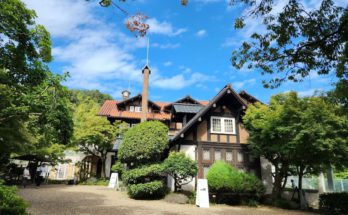

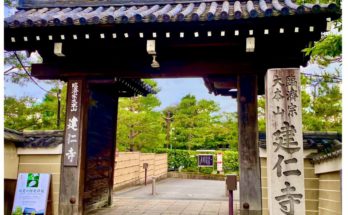
 HTJ has a YouTube page! Check it out
HTJ has a YouTube page! Check it out
Very in detail introduction!
I didn’t know Rozen Kannon.
Always thank you for enjoyable guide!
Thank you for your comment, Masayo-san! Ryozen Kannon is not well known because it cannot be seen from the Nene-no-michi even though it is that big. Let’s take a stroll around that area to see the statue!
Rieko, your article on Yasaka Shrine in Kyoto is a captivating journey, akin to strolling alongside a knowledgeable friend. Your vivid descriptions and insights make me feel connected to the spiritual ambiance and historical richness of Yasaka Shrine. The article beautifully captures the spirit of the place, offering a delightful virtual tour for those who can’t be there in person.
Well done!
Hi Irena, Thank you for your lovely comments! I am glad you enjoyed reading the article. I also hope those who can’t actually be there in person enjoy reading it.
If you don’t mind the intense summer heat in Kyoto, come see the Gion Festival next time. It is a gorgeous festival!